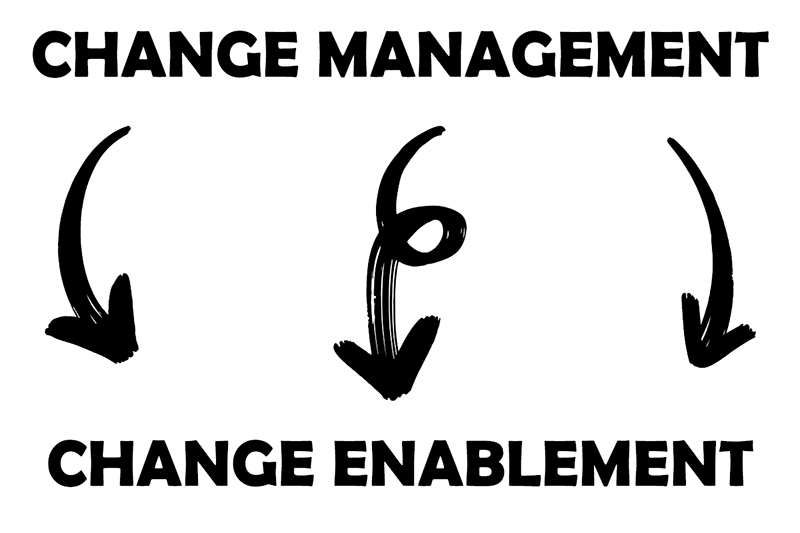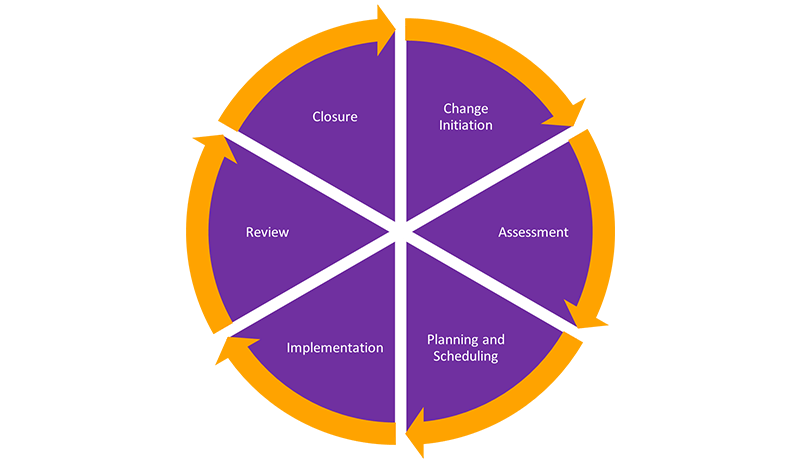Change Management is important as it helps organisations manage changes to their IT systems and services in a structured and controlled manner.
Change Management processes ensure that changes are evaluated, approved, and implemented in a way that minimises risks to the organisation's operations and services.
Change Management improves communication, collaboration, increases change efficiency through continuous improvement.
- What Is ITIL® Change Management?
- What Is A Change In ITIL®?
- What Is Change Management In ITIL®?
- Why Is ITIL® Change Management Important?
- What Are The Main Changes In ITIL®?
- What Is The Change Management Process Flow?
- ITIL® Change Management Best Practices
- Examples Of When Change Management Might Be Required
- Change Management KPIs To Track
- Change Management Roles & Responsibilities
- What Are The Advantages Of The ITIL® Change Management Process?
- What Are The Pitfalls & Disadvantages Of The ITIL® Change Management Process?
- Final Notes On ITIL® Change Management
What Is ITIL® Change Management?
Change Management is an ITIL® V3 process in the service lifecycle stage of Service Transition. ITIL® 4 no longer focuses on processes but instead shifts focus onto 34 practices giving organisations the freedom to define their own processes.

When ITIL® 4 was introduced the ITIL® V3 Change Management process was turned into a ITIL® 4 practice called ‘Change Control’, its name was then later changed to ‘Change Enablement’ due to language translation issues.
ITIL® 4 introduced a number of new concepts and practices that can be complex and challenging to implement effectively. However, with the right approach, training, and support, your organisation can reap the benefits of ITIL® 4, including improved service quality, increased customer satisfaction, and better alignment with business goals.
In this article we will be discussing Change Management in detail types of changes, the Change Management process flow, Change Management roles and responsibilities, best practices, KPIs, the advantages and disadvantages of Change Management.
(Check out this post for a closer look at - what is ITIL 4?)
What Is A Change In ITIL®?
A change within ITIL® is a change within the IT Infrastructure of an organisation that can affect the service of an organisation. It is important that a change is aligned with the organisations goals and provides value.
The ITIL® definition of a change is “the addition, modification or removal of any authorised, planned, or supported service or service component that could have an effect on IT services”.
Types Of Changes
There are 4 different types of changes in ITIL®; major, standard, minor, and emergency change. By categorising changes into different types, organisations can develop processes and procedures that are tailored to the specific requirements and risks. This helps ensure that changes are managed effectively, a high level of service quality is maintained, and minimises risks.
Major Change
Major change is a high risk and/or high impact change that could potentially interrupt live environments if not planned and implemented correctly. A major change requires management approval along with CAB (Change Advisory Board) approval. With a major change the RFC (Request For Change) contains a detailed proposal on cost benefits and risk impact analysis. Because major changes can have significant impact on the organisation, they often require more planning, preparation, and stakeholder engagement. As a result, they require more resources and longer timelines for implementation.
Examples of major changes include:
- Implementing a new ERP (Enterprise Resource Planning) system.
- Merging with another organisation.
- Relocating to a new facility.
- Rolling out a new product line.
- Changing the organisation's business model.
- Upgrading or replacing a critical system or infrastructure component.
- Reorganising the company's structure or management team.
Standard Change
A standard change is a low risk and low impact change that is pre-defined and pre-approved. standard changes are periodical changes that follow a standard operating procedure. Standard change approval happens once initially and does not require CAB approval every time. Organisations can establish standard change procedures that define the specific types of changes that are considered standard. From this, the Change Management team can work more efficiently and reduce the workload and free up resources.
Examples of standard changes include:
- Adding or removing user accounts.
- Applying security patches to software.
- Changing the backup schedule for a server.
- Updating a software configuration setting.
- Adding new hardware to an existing system.
- Installing a new software application.
- Conducting routine maintenance on a system.
Minor Change
A minor change is a non-trivial change that has low impact and low risk. Typically, minor changes require less planning and preparation, but may still require some level of review and approval to ensure that they are completed correctly and do not introduce significant risk. Minor changes may be handled through a separate more streamlined Change Management process or through a CAB. It is important to document relevant information for future reference.
Examples of Minor Changes include:
- Changing a process in a minor way.
- Updating a minor configuration on a system.
- Installing a minor software upgrade.
- Changing a minor hardware component.
- Updating documentation for a process.
- Making minor changes to a website.
- Adding a minor feature to a software application.
Emergency Change
Emergency changes are to address unexpected disruptions that need to be resolved as soon as possible. Emergency changes typically handle RFC retrospectively post implementation. It is crucial for the Emergency CAB (ECAB) to understand the impact and handle approvals. Emergency changes are typically initiated outside of the normal Change Management process including the request for change and Change Advisory Board. An emergency change may require an expedited review and approval process to minimise the impact of the issue. A post review is critical after implementation to understand the potential risks. Documentation of this change is vital for future reference.
Examples of Emergency Changes include:
- Restoring a failed system or service.
- Patching a critical security vulnerability.
- Replacing a failed hardware component.
- Addressing a major network outage.
- Addressing a critical software bug.
What Is Change Management In ITIL®?
Change Management is a set of processes and procedures within the ITIL® framework that provides a systematic approach for managing changes to IT systems, services, and infrastructure. ITIL® Change Management is designed to minimise the impact of changes on IT services, while ensuring that the changes are controlled and aligned with the organisation's goals and objectives.
ITIL® Change Management is a key part of the ITIL® framework, it is closely related to other parts of IT Service Management (ITSM) such as configuration management, release management, and incident management.
(Click here if you might be interested in our incident management training and qualification).
Why Is ITIL® Change Management Important?
Change Management is important as it helps organisations minimise risk of disruption, improves efficiency with a systematic approach, and supports continuous improvement. Change Management helps organisations ensure that changes to their IT systems, services, and infrastructure are controlled, efficient, and aligned with their goals.
The main positive impacts of Change Management to an organisation are:
Minimises The Risk Of Disruption
Change Management helps to minimise the risk of disruption to IT services by ensuring that changes are properly planned, tested, and authorised before they are implemented.
Improves Efficiency
By having a structured and systematic approach to Change Management, organisations can reduce the time and resources required to implement changes, resulting in improved efficiency.
Supports Compliance
Change Management can help organisations comply with regulations and standards, such as those related to data privacy and security, by ensuring that all changes are properly documented, approved, and tracked.
Increases Transparency
Change Management provides transparency into the change process, making it easier for organisations to understand why and how changes are being made to their IT systems, services, and infrastructure.
Enhances Collaboration
Change Management encourages collaboration between different departments and stakeholders, such as IT, business units, and external suppliers, ensuring that all changes are aligned with the organisation's goals and objectives.
Supports Continuous Improvement
Change Management provides a framework for continuously improving IT services, by ensuring that all changes are regularly reviewed and evaluated, and that lessons learned are incorporated into future Change Management processes.
What Are The Main Changes In ITIL®?
The most common changes in ITIL® can vary depending on the specific needs and objectives of an organisation, but some of the most common changes include: Technology, Process, Policy, Resources, and Strategic changes. ‘Organisational Change Management’ is a separate ITIL® 4 Practice that covers change around attitude, behaviour, cultural, organisational and people.
Technology Changes
This can include the implementation of new software systems, hardware upgrades, or the migration to cloud-based solutions.
Process Changes
This can include changes to business processes, workflows, or organisational structures, aimed at improving efficiency, effectiveness, or competitiveness.
Policy Changes
This can include changes to rules, procedures, or guidelines, aimed at improving compliance, risk management, or governance.
Strategic Changes
This can include changes to the overall strategy or direction of the organisation, aimed at adapting to market trends, emerging technologies, or changing customer needs.
Regulatory Changes
This can include changes to laws, regulations, or standards that impact the technology underpinning operations of the organisation, and may also require changes to policies, processes, or systems.
What Is The Change Management Process Flow?
The Change Management process flow typically follows these steps:
- 1. Change initiation.
- 2. Assessment.
- 3. Planning and scheduling.
- 4. Implementation.
- 5. Review.
- 6. Closure.

Change Initiation
This is the first stage of the Change Management process, where a change request is received and evaluated to determine if it is a candidate for further consideration. Typically, this stage reviews if the request for change is aligned with the organisations goals and if it is value driven.
Assessment
In this stage, the change request is assessed to determine the impact and risk that the change may have on IT services, and to identify any dependencies or stakeholders that may be affected.
Planning & Scheduling
A plan for implementing the change is developed, including the resources, schedule, and testing requirements.
Implementation
The change is implemented following the approved plan, all relevant stakeholders are notified and supplied with documentation if needed.
Review
After the change has been implemented, it is reviewed to determine if it has been successful, if any lessons can be learned, and if any changes to the Change Management process are required.
Closure
Once the change has been successfully implemented and reviewed, the change request is closed, and the change is documented in the configuration management database.
This process flow may vary depending on the specific needs and requirements of an organisation, some organisations may add additional processes, but the basic steps remain the same. It's important to note that the Change Management process is not a one-time event, but a cycle that should be regularly reviewed and improved. Continual improvement should be implemented and aligned with the organisation's goals.
ITIL® Change Management Best Practices

Best practices are a set of guidelines, methods, or techniques that are recognised as effective in achieving optimal results for your organisation. These Change Management practices have been developed and refined over time through experience, research, and experimentation. Here are some of our best practices for ITIL® Change Management:
Clearly Defined Roles & Responsibilities
Your Change Management process should clearly define the roles and responsibilities of all parties involved, including the change manager, change advisory board, and change implementers.
Integration With Other ITSM Processes
It is essential Change Management is integrated with other ITSM processes, such as incident management, problem management, and configuration management, to ensure that all changes are aligned with the objectives of your organisation.
Risk Assessment
Changes should be assessed for their impact and risk before they are implemented. The results of your assessment should be used to prioritise changes and determine the most appropriate course of action.
Regular Review & Improvement
Your Change Management process should be regularly reviewed and improved to ensure that it remains effective and aligned with your organisation's goals.
Communication
Effective communication is essential for successful Change Management. Regular and timely communication should be maintained with all your stakeholders, including business units, IT, and external suppliers.
Documentation
Your Change Management process should be well documented, and all changes should be documented in your organisations Configuration Management Database (CMDB).
Testing
Changes should be thoroughly tested before they are implemented, to minimise the risk of disruption to your IT services.
Involvement Of Stakeholders
All your relevant stakeholders, including business units, IT, and external suppliers, should be involved in the Change Management process to ensure that changes are aligned with the organisation's goals and objectives.
Continuous Improvement
Your Change Management process should be continuously improved based on lessons learned, feedback from stakeholders, and changes in your organisation’s environment.
By following these best practices, you can improve the efficiency and effectiveness of the ITIL® Change Management process, minimise the risk of disruption to IT services, and ensure that changes are aligned with goals and objectives of your organisation.
Examples Of When Change Management Might Be Required
Essentially, any change to your organisation's products, services, infrastructure, or processes that could impact the organisation's ability to deliver services or protect data should be managed through a formal Change Management process. This helps ensure that changes are implemented in a controlled manner so you can maintain a high level of service quality and security.
Here are some examples of changes that Change Management should manage:
Implementing a new software application: This can involve a big change to your organisation's IT infrastructure. Careful planning and testing are required to ensure that the implementation is correct and doesn't negatively impact other systems or services.
Upgrading an existing system: This change requires planning and testing to ensure that the upgrade doesn't introduce new risks or issues.
Changing a business process: This can involve changes to the way work is performed within your organisation, it can impact multiple teams and departments. Changes to business processes should be carefully planned and communicated to ensure that everyone is aware of the changes and understands how to adapt to them.
Installing new hardware: Changes to your organisation's IT infrastructure requires careful planning and testing to ensure that the new hardware is installed correctly to reduce the risk of impact to other systems or services.
Changing access controls: Changing the way that users access your organisation's IT systems and applications can have a significant impact on security and data protection. Changes to access controls should be carefully managed to ensure that only authorised users have access to sensitive data and systems.
Changes to software licenses: Changes to software licences involves your organisation's software applications such as upgrading to a new version of a software application or changing licensing models for a software product. Changes to software licenses can impact your organisation's ability to use its software applications and can introduce new costs and risks such as non-compliance fines.
All of the above changes may be categorised into a different level of change depending on their impact on your organisation such as major, minor, standard, and emergency change. Each of these changes will be handled differently using your organisations Change Management processes.
Change Management KPIs To Track

KPIs (Key Performance Indicators) can help you to assess the effectiveness of your Change Management process and identify areas for improvement. By monitoring these metrics regularly, your organisation can ensure that the Change Management process is meeting the needs of your business and is providing the necessary level of service quality and risk management.
It is also important to add that the way you track metrics for KPIs is vastly important, for example; You want to measure your implementation efficiency, tracking the average time to implementation rather than tracking how many change implementations take over a number of days is better.
Here are a few useful KPIs to track:
An Overall Reduction In The Number Of Failed Changes
This measures the percentage of changes that fail or are rolled back due to incidents or problems. A low change failure rate indicates that your Change Management process is effective in identifying and addressing risks.
An Increase In Your Overall Change Success Rate
Tracking the percentage of successful changes is a terrific KPI to pay attention to. A high change success rate indicates that the Change Management process is effective in managing changes and minimising risks.
Customer Satisfaction
This measures the satisfaction of customers and stakeholders with the Change Management process. A high level of customer satisfaction indicates that the Change Management process is meeting the needs and expectations of the organisation.
A Reduction In The Backlog Of Change Requests
Unfortunately not all change requests can be handled as they are received, and many end up waiting in a backlog. Measuring the number of changes that are waiting to be implemented can indicate flaws in your Change Management process or provide assurance that the process is efficient. A high change backlog indicates that your Change Management process is not able to keep up with the demand, which can impact on your service delivery.
Change Success Rate By Type
By tacking the success rate of different types of changes, such as standard changes, emergency changes, and major changes. This can help your organisation to identify which types of changes are more prone to failure and to take steps to reduce the risk of incidents in the future.
Changes Completed On Time
The percent of changes completed on time. This indicates whether the change process is working at optimum efficiency. The higher the percent, the better your Change Management process. If it is a lower percentage this indicates that you may need to review your change process.
Change Acceptance Rate
The percentage of changes that were approved by the CAB. This indicates the effectiveness of your change requests and change plans. Higher percentage is a sign of good changes and planning. A Lower percentage indicates poor change planning which requires review.
Change Lead Time By Category
By measuring the average time it takes to implement changes based on their category, such as hardware changes, software changes, and process changes. By tracking change lead time by category, your organisation can identify which types of changes take longer to implement and take steps to reduce lead times.
Change Management Roles & Responsibilities

The role of the change manager is to plan, implement, and monitor changes in an organisation. They ensure that changes are aligned with business objectives and are implemented in an effective manner. The responsibilities of the change manager vary organisation to organisation. Here are a few of the most common:
Developing &, Implementing The Change Management Process
This responsibility includes defining the steps involved in the Change Management process, such as assessing change requests, conducting impact assessments, and communicating changes to stakeholders.
Assessing Change Requests
Evaluating the business impact, feasibility, and risks associated with change requests, and determining if they should be approved or rejected.
Conducting Impact Assessments
This includes identifying the potential impacts of changes on business processes, systems, and personnel, and developing contingency plans to mitigate risks.
Communicating Changes To Stakeholders
This includes keeping stakeholders informed and ensuring that they understand the impact of the changes.
Coordinating Implementation
Working with relevant departments and personnel to ensure that changes are implemented as planned, and that if any issues or problems arise, they are resolved.
Monitoring & Evaluating Changes
Tracking progress of changes and evaluating the results to determine if they have achieved the intended objectives.
Managing The Change Backlog
This responsibility involves prioritising change requests and ensuring that they are processed efficiently.
Continually Improving The Change Management Process
Reviewing the Change Management process regularly and making changes as needed to improve efficiency and effectiveness.
The change manager plays a critical role in ensuring that changes are aligned with business objectives and are implemented in a way that minimises disruption.
What Are The Advantages Of The ITIL® Change Management Process?
Implementing a structured Change Management process brings benefits to an organisation such as improved risk management, organisational agility, alignment with business objectives, better collaboration and communication, increased visibility, and increased stakeholder satisfaction.
Improved Efficiency
By having a systematic and well-defined process in place, Change Management can help to streamline the change process and reduce the amount of time and resources required to implement a change.
Increased Stakeholder Satisfaction
Involving stakeholders in the change process and keeping them informed about changes, Change Management can help to increase stakeholder satisfaction and reduce resistance to future changes.
Improved Risk Management
By assessing the potential risks associated with changes and developing contingency plans to mitigate those risks, Change Management ensures to minimise the impact of change related disruptions to the service and ensures business continuity.
Enhanced Organisational Agility
By making changes in a controlled and consistent manner, Change Management can help organisations to respond quickly and effectively to changing business needs and market conditions.
Improved Alignment With Business Objectives
By ensuring that changes are aligned with the overall strategy and goals of the organisation, Change Management ensures to maximise the benefits of change and the changes are consistent with the organisation's vision.
Better Collaboration & Communication
By involving stakeholders in the Change Management process and ensuring that changes are communicated, Change Management can help to foster effective collaboration and communication among departments and teams.
Increased Visibility Into The Change Process
By tracking changes and evaluating the results, Change Management can provide your organisation with greater visibility into the Change Management process and help to identify areas for continual improvement.
What Are The Pitfalls & Disadvantages Of The ITIL® Change Management Process?
While Change Management brings many benefits, there are also some disadvantages to consider. Such as but not limited to; stakeholders resistant to change, increased bureaucracy, prioritisation, and increased cost.
Increased Cost
Implementing a structured Change Management process can require significant time and resources, including training, process development, and increased staff time which results in an increase of expenditure for your organisation.
Bureaucracy & Red Tape
Having a formal Change Management process in place can lead to increased bureaucracy and slow down the change process, making it more difficult for your organisation to respond quickly to changing business needs. The process therefore needs to be as lean as possible but with just the appropriate level of control.
Resistance To Change
Despite the best efforts of change managers, some stakeholders within your organisation may still resist changes and resist adoption of new processes or technologies.
Difficulty In Prioritising Changes
With multiple change requests coming in, it can be difficult for your organisation to prioritise changes and ensure that the most important changes are addressed first.
Complexity
Change Management processes can be complex and difficult to understand, particularly for stakeholders who are not directly involved in the Change Management process.
Lack Of Flexibility
By having a formal Change Management process in place, it may be harder to respond quickly and effectively to unexpected changes, such as those caused by external factors like market changes or competitive threats.
Implementation Challenges
The success of Change Management processes depends on the effective implementation of changes, and there may be challenges in getting all stakeholders to adopt new processes or technologies.
Despite these disadvantages, the benefits of Change Management often outweigh the costs and challenges. Organisations that implement Change Management effectively can experience significant benefits.
Final Notes On ITIL® Change Management
In today's fast-paced business world, change is inevitable. Change Management helps to minimise the risk of disruption to business operations, while also ensuring that changes are implemented effectively and efficiently with increased customer satisfaction.
Change Management promotes a culture of continuous improvement, where employees are encouraged to identify opportunities for improvement and take ownership of the change process. This can lead to increased employee engagement, better communication and collaboration, and a more agile and responsive organisation.
Overall, Change Management is an essential process for any organisation that wants to stay competitive and thrive in today's fast-paced business environment.
As mentioned earlier in the article ITIL® 4 has no specific course on Change Management when it transitioned from ITIL® V3.
Here at Purple Griffon, we see the importance of Change Management and created our own 2-day Change Management Workshop. The course combines the ITIL® V3 process and the ITIL® 4 Change Enablement practice into a one-day masterclass.
If you enjoyed our blog on Change Management, why not sign-up to our newsletter to get notified when new blogs are released!




